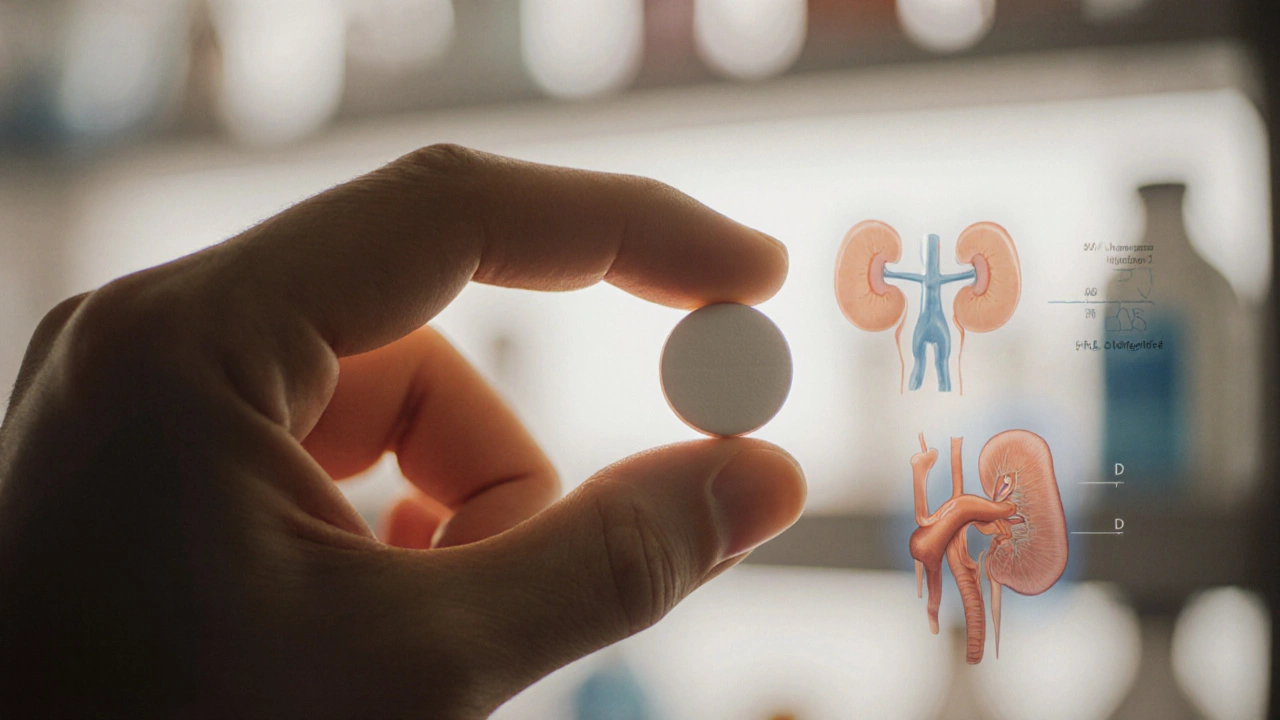Diuretic Selector Tool
Your personalized recommendation will appear here after selecting options and clicking "Find Best Diuretic Alternative".
When it comes to managing hypertension, hydrochlorothiazide remains a go‑to option. Hydrochlorothiazide is a thiazide diuretic that works by blocking sodium reabsorption in the distal convoluted tubule, helping the body shed excess water and lower blood pressure. It’s sold under brand names like Microzide and has been on the market since the 1960s.
Why Hydrochlorothiazide Still Matters
Doctors love it because the pill is cheap, taken once daily, and reduces both systolic and diastolic pressure by about 10mmHg on average. For most adults, a starting dose of 12.5mg-25mg works fine, and the drug’s half‑life of roughly 6‑15hours means steady blood levels with minimal peaks.
But no drug is perfect. Common complaints include increased urination, low potassium, and occasional dizziness. Those side effects lead many patients and clinicians to explore alternatives.
Alternative 1: Chlorthalidone
Chlorthalidone is a thiazide‑like diuretic that shares the same sodium‑blocking mechanism but has a longer half‑life (40‑60hours). Because it stays in the system longer, a single daily dose of 12.5mg-25mg often provides steadier blood‑pressure control. Studies from 2023 show chlorthalidone may reduce cardiovascular events slightly more than hydrochlorothiazide, though its risk of low potassium is a touch higher.
Alternative 2: Indapamide
Indapamide is another thiazide‑like agent, marketed as a “low‑dose” option. Its half‑life sits around 14‑24hours, and the typical dose is 1.5mg once daily. Indapamide tends to cause fewer electrolyte disturbances, making it a favorite for patients who have struggled with potassium loss on other thiazides.
Alternative 3: Furosemide
Furosemide belongs to the loop‑diuretic class, acting higher up in the kidney’s nephron to block sodium‑potassium‑chloride reabsorption. It’s a powerhouse for rapid fluid removal, used in heart‑failure and severe edema. Doses range from 20mg to 80mg daily, but the drug can cause more pronounced electrolyte shifts, especially low calcium and magnesium.

Alternative 4: Spironolactone
Spironolactone is a potassium‑sparing diuretic that works by antagonising the aldosterone receptor. Typical doses for hypertension sit at 25mg-50mg daily. Because it retains potassium, it’s often paired with a thiazide to counteract hypokalemia. Side effects can include mild breast tenderness and occasional hormonal changes.
Alternative 5: Amiloride
Amiloride is another potassium‑sparing agent, blocking sodium channels in the distal tubule. It’s usually prescribed at 5mg-10mg daily, often together with a thiazide. Its main benefit is preventing low potassium, but it can raise blood sugar slightly in diabetics.
Alternative 6: Lisinopril (ACE‑inhibitor)
Lisinopril isn’t a diuretic, but it’s a top‑ranked first‑line drug for hypertension. It works by blocking the conversion of angiotensin I to angiotensin II, relaxing blood vessels. The usual dose is 10mg-40mg once daily. Patients who can’t tolerate diuretics often switch to an ACE‑inhibitor, though a dry cough can be a deal‑breaker.
Side‑Effect Snapshot
- Hydrochlorothiazide - low potassium, increased urination, mild dizziness.
- Chlorthalidone - stronger potassium loss, longer‑lasting blood‑pressure effect.
- Indapamide - fewer electrolyte swings, useful in older adults.
- Furosemide - rapid fluid removal, risk of low calcium, magnesium.
- Spironolactone - potassium retention, possible hormonal side effects.
- Amiloride - modest potassium sparing, may raise glucose.
- Lisinopril - cough, rare angio‑edema, excellent for kidney protection.
Head‑to‑Head Comparison
| Drug | Class | Typical Dose | Half‑Life | Primary Use | Major Side‑Effect |
|---|---|---|---|---|---|
| Hydrochlorothiazide | Thiazide diuretic | 12.5‑25mg daily | 6‑15h | Hypertension, mild edema | Hypokalemia |
| Chlorthalidone | Thiazide‑like diuretic | 12.5‑25mg daily | 40‑60h | Hypertension, high‑risk CV patients | Hypokalemia (more pronounced) |
| Indapamide | Thiazide‑like diuretic | 1.5mg daily | 14‑24h | Hypertension, especially in elderly | Less electrolyte loss |
| Furosemide | Loop diuretic | 20‑80mg daily | 2‑4h | Heart failure, severe edema | Low calcium, magnesium |
| Spironolactone | Potassium‑sparing diuretic | 25‑50mg daily | 1‑2h (active metabolite 13‑15h) | Resistant hypertension, hyperaldosteronism | Hormonal side‑effects |
| Amiloride | Potassium‑sparing diuretic | 5‑10mg daily | 6‑9h | Adjunct to thiazides | Hyperglycaemia risk |
| Lisinopril | ACE‑inhibitor | 10‑40mg daily | 12h | Hypertension, diabetic nephropathy | Dry cough |

How to Choose the Right Option
Think of drug selection like fitting a shoe. You need the right size (dose), the right material (mechanism), and a comfortable feel (side‑effect profile). Here are three quick decision points:
- Kidney function: If eGFR is below 30mL/min, avoid thiazides and consider a loop diuretic or ACE‑inhibitor.
- Electrolyte concerns: Patients prone to low potassium benefit from a potassium‑sparing partner like spironolactone or amiloride.
- Cardiovascular risk: High‑risk patients often do better with chlorthalidone or a combination of a thiazide‑like diuretic plus an ACE‑inhibitor.
Practical Tips & Common Pitfalls
- Start low, go slow - a 12.5mg dose of hydrochlorothiazide can be enough for many, avoid jumping straight to 50mg.
- Never forget potassium - if you’re on a thiazide, check serum potassium after two weeks and supplement if it falls below 3.5mmol/L.
- Watch for drug interactions - NSAIDs can blunt the blood‑pressure‑lowering effect of most diuretics.
- Stay consistent - diuretics work best when taken at the same time each day, preferably in the morning to avoid nighttime trips to the bathroom.
- Consider combination therapy early - adding a low‑dose ACE‑inhibitor often gives better control than doubling the diuretic dose.
Key Takeaways
- Hydrochlorothiazide is cheap and effective but can cause low potassium.
- Chlorthalidone offers longer action and may lower cardiovascular events, at the cost of stronger electrolyte loss.
- Indapamide is gentle on electrolytes, ideal for older adults.
- Loop diuretics like furosemide are for rapid fluid removal, not first‑line hypertension.
- Potassium‑sparing agents (spironolactone, amiloride) balance thiazide‑induced losses, but have their own side‑effects.
Frequently Asked Questions
Can I switch from hydrochlorothiazide to chlorthalidone without a doctor?
No. Both drugs affect kidney function and electrolytes, so a physician should review your labs and adjust the dose safely.
Is it safe to combine a thiazide with a potassium‑sparing diuretic?
Yes, many clinicians pair them to prevent hypokalemia. Monitoring potassium every 2‑4 weeks is still recommended.
Why would a doctor prescribe furosemide for high blood pressure?
Furosemide is usually reserved for patients who also have fluid overload, such as heart‑failure patients, because its rapid diuretic effect can lower volume‑related pressure.
Do ACE‑inhibitors work better than thiazides?
They work differently. ACE‑inhibitors protect kidneys and are great for diabetics, while thiazides are simple, cheap, and effective for most adults. The best choice often combines both.
What should I do if I develop a dry cough on lisinopril?
Tell your doctor. They may switch you to an ARB (angiotensin‑II receptor blocker) which has the same blood‑pressure benefit without the cough.
Next Steps & Troubleshooting
If you’re already on hydrochlorothiazide and noticing leg cramps or fatigue, grab a recent blood test and check potassium and magnesium levels. Low numbers mean you might need a supplement or a switch to indapamide. If your blood pressure isn’t dropping after 4-6 weeks on the max tolerated thiazide dose, consider adding a low‑dose ACE‑inhibitor or swapping to chlorthalidone. For patients with chronic kidney disease (eGFR<30), jump straight to a loop diuretic or an ACE‑inhibitor-thiazides lose effectiveness when kidney function declines. Finally, keep a simple log: medication name, dose, time taken, and any side‑effects. Bring that log to every appointment. It speeds up adjustments and puts you in control.

Warren Workman
October 5, 2025 AT 17:12
While the mainstream discourse glorifies hydrochlorothiazide as a first‑line thiazide, the pharmacokinetic profile-particularly its 6‑8 hour half‑life and propensity for electrolyte perturbation-renders it suboptimal for patients with compromised renal clearance; let’s not ignore the mechanistic advantages of potassium‑sparing alternatives such as spironolactone, which modulate the renin‑angiotensin‑aldosterone axis more physiologically.
Kate Babasa
October 6, 2025 AT 12:39
Indeed, the comparative efficacy of thiazide‑type diuretics versus loop diuretics warrants a nuanced, evidence‑based appraisal; however, it is equally vital to contextualize therapeutic selection within the patient’s comorbid landscape, ensuring that clinicians balance natriuretic potency with tolerability, thereby fostering optimal adherence.
king singh
October 7, 2025 AT 08:05
Sounds solid, thanks for the overview.
Michelle Dela Merced
October 8, 2025 AT 03:32
🇺🇸 Wow, this diuretic showdown feels like a battle for our very blood pressure freedom! Who knew a tiny pill could spark such drama? 😱💊
Alex Iosa
October 8, 2025 AT 22:59
It must be noted that pharmaceutical lobbying often obscures the true comparative risk–benefit profile of hydrochlorothiazide, steering prescribers toward profit‑driven selections rather than patient‑centred outcomes.
melissa hird
October 9, 2025 AT 18:25
Oh, absolutely-because the only thing more thrilling than a diuretic is the clandestine boardroom where they decide which one gets the spotlight. 😏
Mark Conner
October 10, 2025 AT 13:52
Let’s be real, America’s got the best doctors, and we know the right diuretic for the job-nothing beats the classics that keep our arteries humming.
Charu Gupta
October 11, 2025 AT 09:19
While the discourse is engaging, it is imperative to adhere to precise medical terminology; for instance, “eGFR” should be capitalized, and “diuretic” not “diuretic’s”. 📚
Abraham Gayah
October 12, 2025 AT 04:45
Seriously? We're getting into grammar drills while patients are waiting for a prescription that actually works? 🙄
rajendra kanoujiya
October 13, 2025 AT 00:12
Even though the table looks polished, the real-world adherence rates for hydrochlorothiazide plummet when side effects hit, so the so‑called “alternatives” are just a marketing mirage.
Beverly Pace
October 13, 2025 AT 19:39
One must consider the ethical responsibility of prescribing medications that prioritize patient safety over pharmaceutical profit motives.
RALPH O'NEIL
October 14, 2025 AT 15:05
The comparative data seems exhaustive, yet I wonder how the selection algorithm accounts for individual variability in thiazide sensitivity versus loop diuretic responsiveness.
Mark Wellman
October 15, 2025 AT 10:32
Okay, so first off, let me just say that the whole diuretic selector thing feels like a fancy spreadsheet made by accountants who have never actually prescribed anything. The user interface is slick, but slick doesn’t cure hypertension. I’ve seen patients hop on hydrochlorothiazide and then bail because the sudden drop in potassium makes them feel like they’re on a rollercoaster. Meanwhile, the so‑called “alternatives” like indapamide or chlorthalidone get tossed aside despite having longer half‑lives. In real clinics, we don’t have time to stare at interactive tables; we need quick, evidence‑based answers. The tool’s reliance on eGFR categories is a good start, but it ignores the fact that many patients have fluctuating renal function. Also, the dosing recommendations are vague-what does “normal” even mean in terms of mL/min? If you’re a newbie doc, you might just pick the first option and hope for the best. That’s not how medicine works. The jargon is there, but it’s like a textbook you can’t close. I’ve tried a few of these alternatives on my own, and the side‑effect profiles were a mixed bag-some turned my ankles into swelling pouches. Let’s not forget that lifestyle changes are a huge part of the equation, something no algorithm can capture. So while the tool is a neat gimmick, it’s not a replacement for good old clinical judgment. Bottom line: use it as a reference, not a prescription. And maybe add a disclaimer for those who think the internet can replace a physician.
Amy Morris
October 16, 2025 AT 05:59
Your candid appraisal is appreciated; indeed, a tool is merely adjunctive, and the physician’s nuanced interpretation remains paramount.
Francesca Roberts
October 17, 2025 AT 01:25
Pro tip: If you’re worried about thiazide‑induced hypokalemia, consider pairing HCTZ with a low‑dose potassium supplement-just don’t forget to monitor serum levels, unless you enjoy surprise cardiac arrhythmias.
Becky Jarboe
October 17, 2025 AT 20:52
Would you happen to have data on the incidence rates of hypokalemia when HCTZ is combined with a potassium‑sparing diuretic versus monotherapy?
Carl Boel
October 18, 2025 AT 16:19
It’s clear that America’s pharmaceutical research has pioneered the most effective diuretic regimens, and we should trust home‑grown studies over foreign meta‑analyses.
Shuvam Roy
October 19, 2025 AT 11:45
While domestic research indeed contributes valuable insights, incorporating diverse international trial data can strengthen our therapeutic algorithms and ensure best practices worldwide.
Jane Grimm
October 20, 2025 AT 07:12
In summation, the comparative exposition presented is riddled with superfluous hyperbole and insufficient clinical granularity, rendering it a decorative rather than substantive resource.